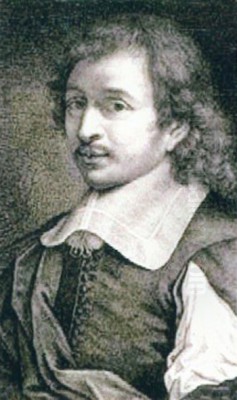
Eustache Le Sueur stands as a significant, if sometimes overlooked, figure in the rich tapestry of 17th-century French art. Born in Paris in 1617 and dying tragically young in 1655, he navigated the transition from the exuberant Baroque imported from Italy to the more restrained, ordered, and distinctly French style known as Classicism. A founding member of the prestigious Royal Academy of Painting and Sculpture, Le Sueur developed a personal style marked by clarity, gentle colour, and quiet emotional depth, earning him the posthumous, though debated, title of the "French Raphael." His career, though brief, produced masterpieces that offer a unique window into the artistic currents of his time, blending influences while forging a path distinct from his more famous contemporaries.
Parisian Roots and Vouet's Workshop
Eustache Le Sueur entered the world in Paris on November 19, 1617. His background provided an early immersion in the arts, as his father, Cathelin Le Sueur, was a master woodworker and sculptor. This familial connection likely eased his entry into the demanding world of artistic apprenticeship. The most crucial step in his formation was joining the studio of Simon Vouet (1590-1649), who was then the dominant force in Parisian painting. Vouet had spent years in Italy, absorbing the lessons of Caravaggio and the Carracci, and returned to France in 1627, bringing a vibrant, decorative Baroque style that quickly found favour with King Louis XIII and the aristocracy.
Vouet's studio was the premier training ground in Paris during the 1630s and early 1640s. It was a bustling environment where young artists learned not only the techniques of painting but also the art of large-scale decoration, composition, and how to cater to elite patrons. Le Sueur proved an adept student, quickly mastering Vouet's manner. However, reports suggest he rapidly developed his own artistic personality, moving beyond mere imitation. While early works might show Vouet's influence in their dynamism and rich textures, Le Sueur soon began to exhibit a preference for greater simplicity, linearity, and a more subdued emotional register.
Forging an Independent Path: The Pull of Classicism
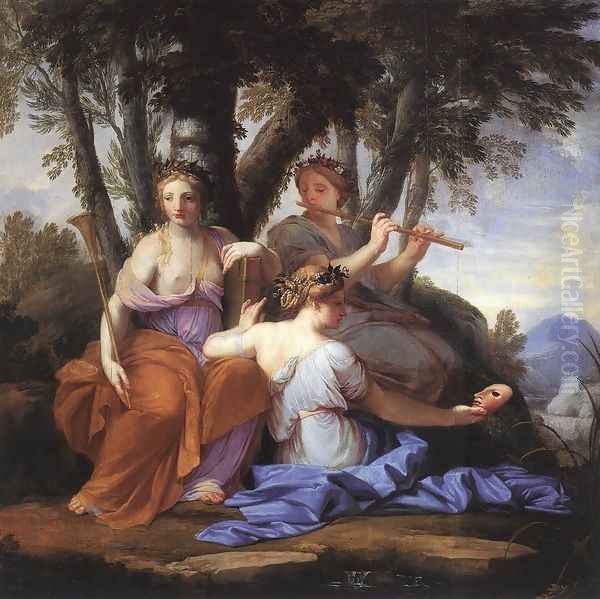
A remarkable aspect of Le Sueur's career, setting him apart from many ambitious contemporaries like Charles Le Brun (1619-1690) or his own master Vouet, is that he never undertook the traditional study trip to Italy. Rome, with its ancient ruins and Renaissance masterpieces, was considered the ultimate finishing school for aspiring history painters. Le Sueur, however, remained in Paris, absorbing Italian influences second-hand. He diligently studied prints and drawings after Italian masters, particularly Raphael (1483-1520), whose grace, clarity, and compositional harmony deeply resonated with him.
He also keenly observed the works of Nicolas Poussin (1594-1665), the leading figure of French Classicism who, although based primarily in Rome, exerted immense influence through his paintings sent back to French patrons and during his brief, somewhat fraught, return to Paris (1640-1642). Le Sueur assimilated Poussin's emphasis on intellectual rigour, carefully constructed compositions, and morally serious themes, but translated them into a gentler, more accessible idiom. His emerging style favoured clear outlines, balanced arrangements, harmonious, often cool colour palettes, and figures imbued with a quiet dignity and sincere piety. This marked a conscious turn away from the more theatrical and sensual aspects of Vouet's Baroque.
The Royal Academy and Professional Standing
The year 1648 was pivotal for French art. Resenting the constraints of the old guild system (the Maîtrise), a group of leading artists petitioned for the establishment of a Royal Academy of Painting and Sculpture, modelled partly on Italian examples like the Accademia di San Luca in Rome. The aim was to elevate the status of painters and sculptors from artisans to practitioners of liberal arts, control training standards, and centralize artistic production under royal patronage. Eustache Le Sueur was among the twelve founding members, the "anciens," alongside figures like Charles Le Brun and Sébastien Bourdon (1616-1671).
His involvement underscores his established reputation by this time. The Academy would become the dominant institution in French art life for the next century and a half, dictating taste and providing a structured path for artistic education and career advancement. Le Sueur's role as a founder, though his early death prevented him from shaping its long-term trajectory as Le Brun did, places him at the heart of this crucial development in the professionalization and centralization of French art.
Masterworks: The Life of St. Bruno
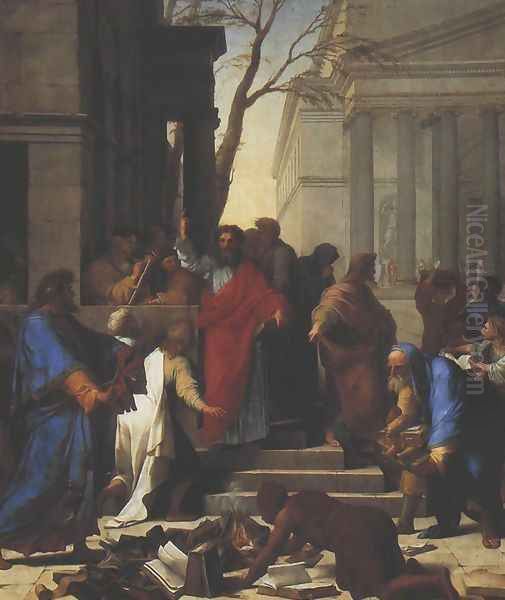
Le Sueur's most celebrated achievement is undoubtedly the series of twenty-two paintings depicting the life of Saint Bruno, founder of the Carthusian Order. Commissioned around 1645-1648 for the small cloister of the Carthusian monastery (Chartreuse) in Paris, this cycle represents the pinnacle of his mature style. The paintings narrate the key moments in the saint's life, from his initial calling to his establishment of the Grande Chartreuse monastery and his death.
Working on canvas, Le Sueur adopted a style perfectly suited to the contemplative life of the monks. The compositions are characterized by their clarity, restraint, and solemnity. He employed a relatively cool palette, dominated by blues, greys, whites, and ochres, creating an atmosphere of serene piety. Figures are noble and expressive, conveying deep emotion through gesture and posture rather than exaggerated facial expressions. Le Sueur masterfully used architecture and landscape to create ordered, believable spaces, employing linear perspective to enhance the narrative's progression. Works like Saint Bruno Attending Raymond Diocres' Lecture, The Death of Saint Bruno, and Saint Bruno's Dream exemplify his ability to convey profound spiritual events with quiet intensity and classical balance. The entire series was acquired by Louis XVI in 1776 and is now a treasure of the Louvre Museum.
Decorative Cycles: The Hôtel Lambert
Beyond religious commissions, Le Sueur also excelled in decorative painting for private residences, a field where his master Vouet had initially made his mark. One of his most significant projects was the decoration of several rooms in the magnificent Hôtel Lambert on the Île Saint-Louis in Paris, undertaken for Jean-Baptiste Lambert de Thorigny and later his brother Nicolas Lambert, starting in the 1640s and continuing into the early 1650s. Here, Le Sueur worked alongside other prominent artists, including Charles Le Brun, providing an opportunity to compare their evolving styles.
Le Sueur was responsible for the Cabinet de l'Amour (Cabinet of Love) and, most famously, the Cabinet des Muses. For the latter, he painted a series celebrating the nine Muses, patrons of the arts and sciences, along with Apollo. These works, such as Clio, Euterpe and Thalia, Melpomene, Erato and Polyhymnia, and Urania, showcase a different facet of his talent. The themes allowed for greater grace and elegance than the austere Life of St. Bruno. The figures are slender and poised, compositions fluid, and the colours perhaps slightly warmer, reflecting the mythological subject matter. Yet, the underlying principles of clarity, balance, and refined drawing remain. These panels, like the St. Bruno series, eventually entered the royal collections and are now housed in the Louvre.
Other Notable Works
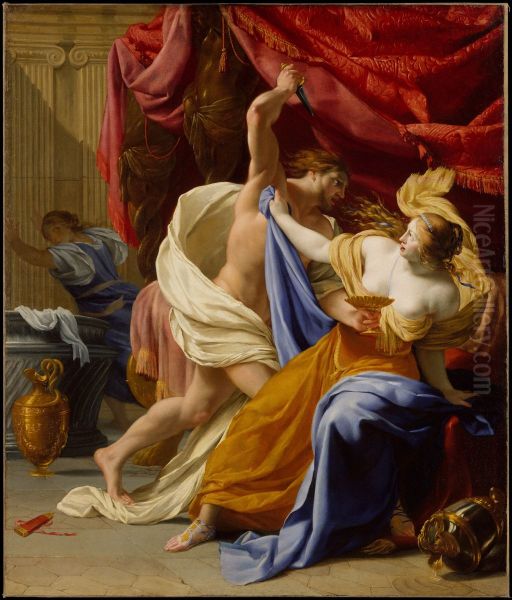
While the St. Bruno cycle and Hôtel Lambert decorations are his most extensive surviving projects, Le Sueur produced numerous other significant paintings, primarily religious. Saint Paul Preaching at Ephesus (1649, Louvre) is a major work commissioned by the goldsmiths' guild for Notre-Dame Cathedral in Paris. It is a complex, multi-figured composition demonstrating his ability to handle large-scale historical subjects with clarity and dramatic organization, clearly influenced by Raphael's tapestry cartoons.
Christ in the House of Martha and Mary (Louvre) displays his characteristic gentle piety and harmonious composition. The Dream of Saint Joseph (various versions exist) treats a common theme with quiet intimacy. The Presentation in the Temple (Louvre) again shows his skill in arranging figures within a classical architectural setting. He also occasionally tackled mythological themes outside the large decorative cycles, such as The Rape of Tamar (c. 1640), demonstrating an ability to depict intense emotion within his typically restrained framework. His oeuvre also includes designs for tapestries, further highlighting his versatility.
Artistic Style: A Synthesis of Grace and Order
Le Sueur's style is often characterized as "Atticism," a term borrowed from rhetoric to describe a clear, pure, and restrained manner, often associated with French Classicism. It represents a synthesis of influences, primarily the compositional harmony and idealized grace of Raphael, the intellectual rigour and narrative clarity of Poussin, and the painterly lessons learned from Vouet, refined into something uniquely his own.
Key elements include:
Emphasis on Drawing (Disegno): Clear contours and carefully modelled forms underpin his compositions.
Balanced Composition: Figures and architectural elements are arranged harmoniously, often employing pyramidal structures or balanced groupings derived from High Renaissance principles.
Subdued Emotion: While his figures express genuine feeling, it is typically conveyed with restraint and dignity, avoiding overt theatricality. Pathos is present but controlled.
Harmonious Colour: Le Sueur favoured palettes that were often cool and gentle, using colour to unify the composition and create atmosphere rather than for purely decorative or dramatic effect. Critics sometimes found his colour lacking warmth or vibrancy compared to Venetian or Flemish masters like Rubens (1577-1640).
Mastery of Perspective: He skillfully employed linear perspective to create convincing, ordered spaces, enhancing the narrative and the sense of classical rationality.
Light and Shadow: His use of chiaroscuro is generally softer and more atmospheric than the dramatic contrasts found in Caravaggio (1571-1610) or Georges de La Tour (1593-1652), contributing to the overall calm and clarity of his scenes.
Contemporaries and Artistic Milieu
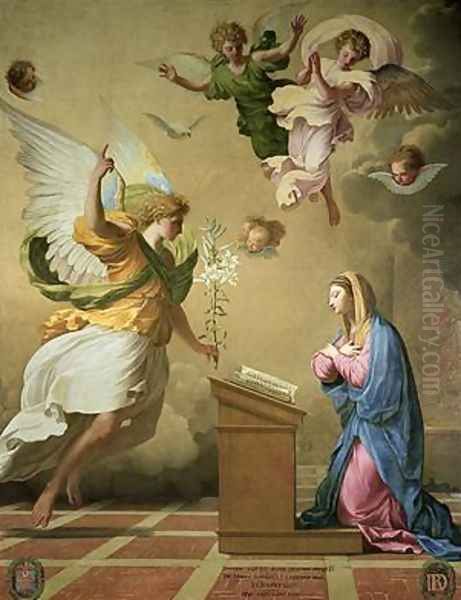
Le Sueur worked within a vibrant and competitive Parisian art world. His relationship with his teacher, Simon Vouet, evolved from student to independent master, eventually offering a stylistic alternative to Vouet's more decorative Baroque. His connection with Nicolas Poussin was one of deep admiration, and tradition holds they were friends, though some accounts mention Poussin expressing jealousy towards Le Sueur's talent – a detail perhaps reflecting later rivalries more than documented fact.
His most direct peer and potential rival was Charles Le Brun. Both trained with Vouet, both were founders of the Academy, and both worked at the Hôtel Lambert. Le Brun, however, possessed greater ambition and political acumen. After Le Sueur's early death, Le Brun would go on to dominate French art under Louis XIV, establishing the official "grand manner" at Versailles, a style more overtly powerful and propagandistic than Le Sueur's intimate classicism.
Other notable contemporaries included Philippe de Champaigne (1602-1674), known for his austere portraits and religious works influenced by Jansenism; Laurent de La Hyre (1606-1656), another classicizing painter known for landscapes and elegant religious scenes; and the versatile Sébastien Bourdon. The broader context included the landscape classicism of Claude Lorrain (1600-1682), based in Rome, and the decorative talents of Pierre Mignard (1612-1695), who would become Le Brun's chief rival. Le Sueur's art drew inspiration from Italian predecessors like Raphael, but also the Bolognese classicism of Annibale Carracci (1560-1609), Domenichino (1581-1641), and Guido Reni (1575-1642), whose works were known through originals and prints.
Final Years and Mysterious End
Le Sueur's life was cut short tragically early. He died in Paris on April 30, 1655, at the age of just 38. The circumstances surrounding his death are somewhat shrouded in anecdote. Tradition relates that he was deeply affected by the death of his wife and subsequently retreated from the world, possibly taking up residence or spending significant time at the Carthusian monastery for which he had painted the St. Bruno cycle. Some accounts even suggest he died there. While the exact details are uncertain, his early demise undoubtedly curtailed a career that was still evolving. It left the field more open for figures like Le Brun to consolidate their dominance in the decades that followed. His decision never to visit Italy remained a distinguishing feature of his biography.
Legacy: The "French Raphael"?
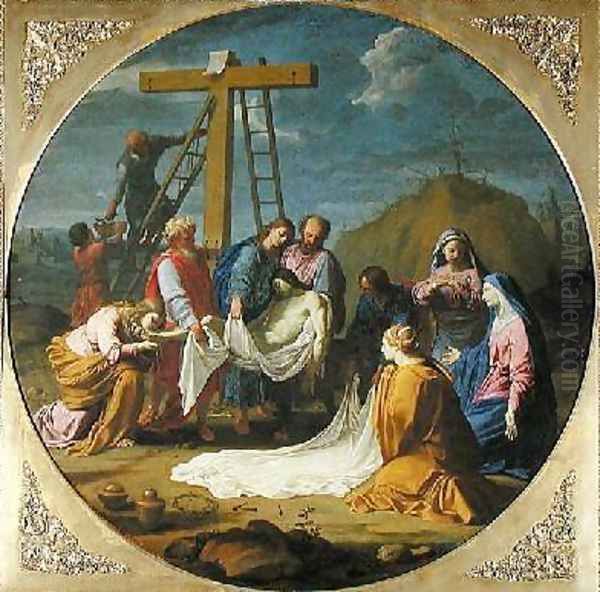
Eustache Le Sueur's reputation has fluctuated over the centuries. He was highly regarded in his time and shortly after, leading to the "French Raphael" comparison. This title acknowledged his stylistic debt to the Urbino master and his own achievements in grace, harmony, and compositional clarity. However, it also became a point of criticism. Some later commentators, particularly in the 18th and 19th centuries, found his work derivative, lacking the power and originality of Raphael or the intellectual depth of Poussin. His colour was sometimes deemed cold or chalky, his figures elegant but perhaps lacking in vigour.
Despite these critiques, Le Sueur holds a secure place in the history of French art. He represents a crucial moment of synthesis, adapting Italian High Renaissance and Baroque ideas to a French sensibility. He offered a distinct strand of French Classicism – less severe than Poussin's, less opulent than Le Brun's, characterized by its sincerity, gentleness, and lyrical grace. His Life of St. Bruno remains one of the great religious cycles of the 17th century, a testament to his narrative skill and ability to convey profound spirituality. As a co-founder of the Royal Academy, he played a role in shaping the institutional framework of French art. While perhaps not possessing the universal fame of Raphael or the towering influence of Poussin, Eustache Le Sueur created a body of work whose quiet beauty and classical refinement continue to resonate. His paintings, primarily housed in the Louvre, offer a compelling vision of faith and artistry from the Grand Siècle.